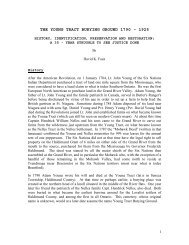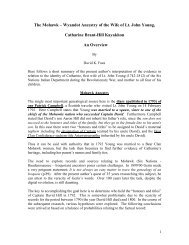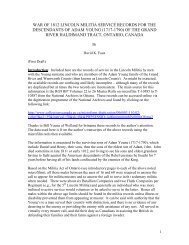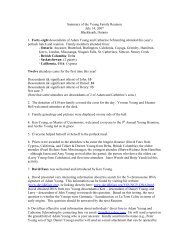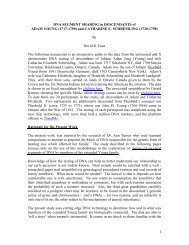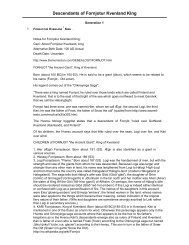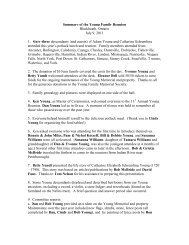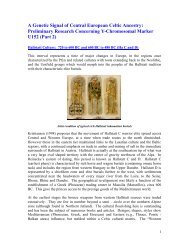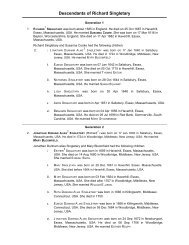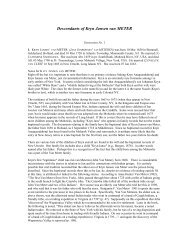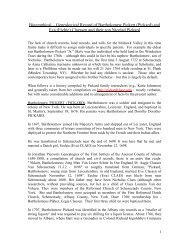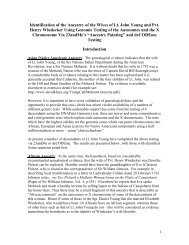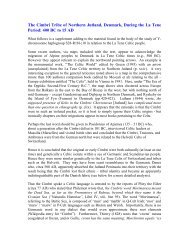Descendants of Hughes I de Cavalcamp Seigneur ... - Davidkfaux.org
Descendants of Hughes I de Cavalcamp Seigneur ... - Davidkfaux.org
Descendants of Hughes I de Cavalcamp Seigneur ... - Davidkfaux.org
You also want an ePaper? Increase the reach of your titles
YUMPU automatically turns print PDFs into web optimized ePapers that Google loves.
Generation 2 (con't)<br />
Conches is to be found close to Tosny. The name has between Toeni (Toenium), Totteneium,<br />
Todiniacum, Thony (Thonaium), and Toni (Toniacum), with minor (1877)- variations, but appears<br />
to be now fixed as Tosny. Toeni and its meadows belonged, as has been stated, to the arch<br />
bishopric <strong>of</strong> Rouen, until alienated by the first Toeni's brother, to give a name and place to the<br />
family in which we are interested." (Madan, p.4 - see below)<br />
"Ralph in the tenth century possessed Castillon (Chatillon) the site <strong>of</strong> an old Roman camp close<br />
to, and in<strong>de</strong>ed part <strong>of</strong>, the town <strong>of</strong> Conches: but this must be regar<strong>de</strong>d at present as due to some<br />
confusion with his son Roger." (Ibid., p.5).<br />
As indicated by Burke's Peerage in notes for Hugh <strong>de</strong> Calvacamp, Ralph received Toeni from<br />
his el<strong>de</strong>r brother Hugh, Archbishop <strong>of</strong> Rouen. The Acta Archiepiscorum Rothomagensium record<br />
that "Hugo" archbishop <strong>of</strong> Rouen granted "Todiniacum…in dominicatu archiepiscopi" to "fratri<br />
suo Radulfo…filio Hugonis <strong>de</strong> Calvacamp.<br />
RALPH (or RODULF) DE TOENI I, son <strong>of</strong> HUGH DE CALVACAMP, was given Tosniby his<br />
brother Hugh, and is <strong>de</strong>scribed as a most powerful man, perhaps inconsequence <strong>of</strong> that gift. He<br />
is usually confused with his son Ralph, butthere is no authority for such i<strong>de</strong>ntification, and the<br />
dates involvedshow that there must have been two Ralphs, belonging to successivegenerations.<br />
[Complete Peerage XII/1:754, (transcribed by DaveUtzinger)][jweber.ged]<br />
A comprehensive (primary research in charters etc.) is "The Early Origins <strong>of</strong> the Tosny Family"<br />
at: http://www -<br />
personal.umich.edu/~bobwolfe/gentxt/Origin_and_early_generations_<strong>of</strong>_the_Tosny_fa mily.pdf<br />
Perhaps even more thorough and <strong>de</strong>tailed is Madan's "The Gresleys <strong>of</strong> Drakelow"<br />
http://ia700305.us.archive.<strong>org</strong>/34/items/collectionsforhi01staf/collectionsforhi01staf.pdf<br />
supporting a Scandinavian line back to the Kings <strong>of</strong> the Norse Sagas.<br />
The name Ralph is not a Scandinavian name, however it would make a good Christian version<br />
<strong>of</strong> Hrolf which is a common Norwegian name. (DKF).<br />
Wiki:<br />
HOUSE OF TOSNY<br />
Notable members:<br />
Coming from Île-<strong>de</strong>-France, the Tosnys first based themselves in Normandy in the 10th century<br />
to collaborate with the <strong>de</strong>scendants <strong>of</strong> the Vikings. They formed part <strong>of</strong> this new elite which<br />
appeared around dukes Richard I and Richard II at the turn <strong>of</strong> the 10th to 11th century. In 991,<br />
Raoul I <strong>of</strong> Tosny witnessed the first surviving international treaty in Normand history (an accord<br />
between Duke Richard I and the Anglo-Saxon king Ethelred II). As one <strong>of</strong> the top Normands, he<br />
set out to fight in southern Italy. His grandson Raoul II took part with the premier barons in the<br />
court <strong>of</strong> William the Conqueror (1035-1087). He was the Normand standard bearer in 1054.<br />
Narratives, more or less legendary, gathered around the family: the chroniclers report the<br />
exploits <strong>of</strong> Roger I, the Moor-Eater, in Hispania. His wife, Go<strong>de</strong>hildis/Gotelina, was linked to a<br />
miracle at Sainte-Foy <strong>de</strong> Conques. At the start <strong>of</strong> the 12th century, the Norman chronicler<br />
Or<strong>de</strong>ric Vitalis explains that the family was <strong>de</strong>scen<strong>de</strong>d from Malahulce, uncle <strong>of</strong> Rollo.<br />
A mo<strong>de</strong>l aristocratic family:<br />
Formation <strong>of</strong> its power<br />
As with several Norman families (such as the Beaumont), the origin <strong>of</strong> the house <strong>of</strong> Tosny's<br />
power <strong>de</strong>rived from two sources : recovery <strong>of</strong> church goods. According to Lucien Musset,<br />
Hugues, archbishop <strong>of</strong> Rouen (942-989) split <strong>of</strong>f lands from his cathedral's lands and gave them<br />
to his brother Raoul I <strong>of</strong> Tosny



